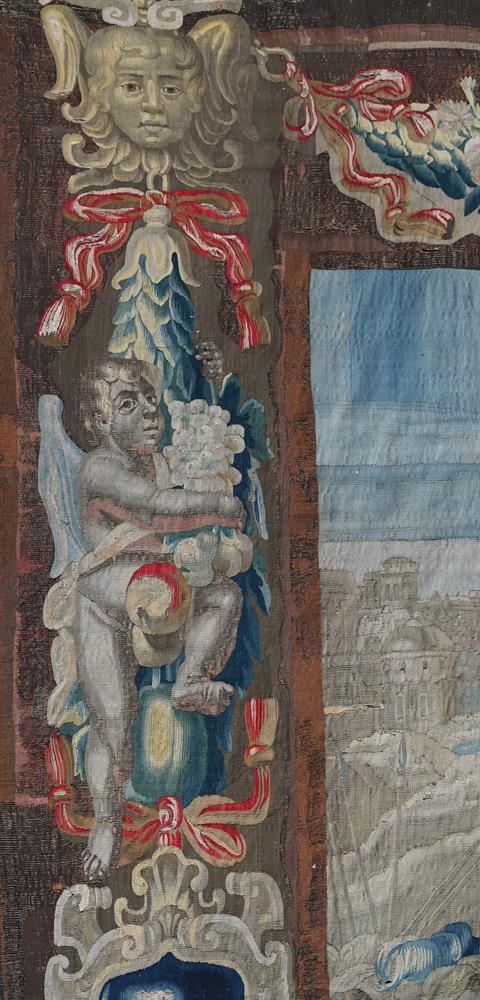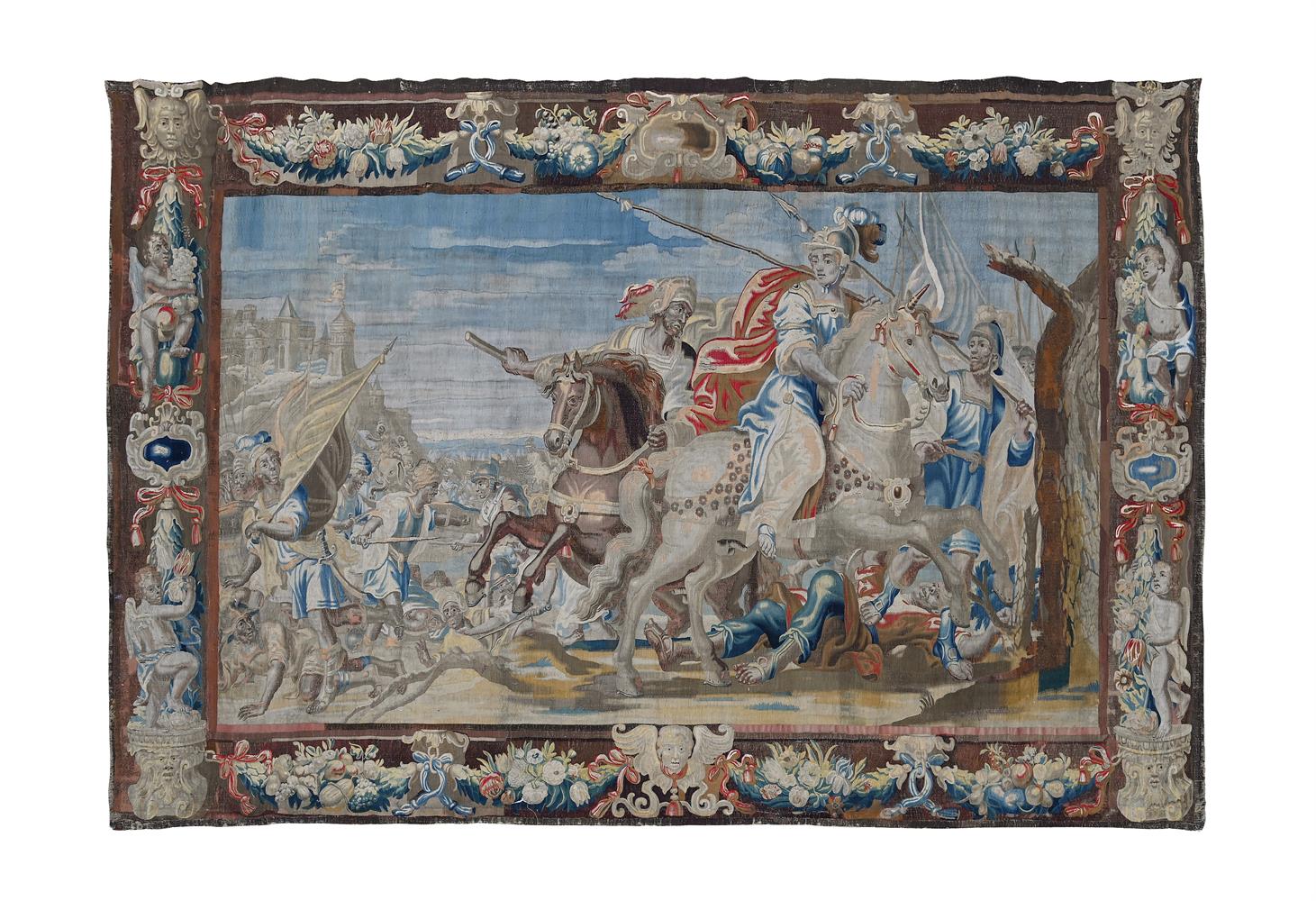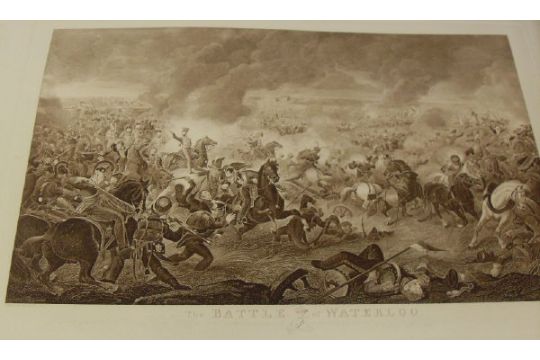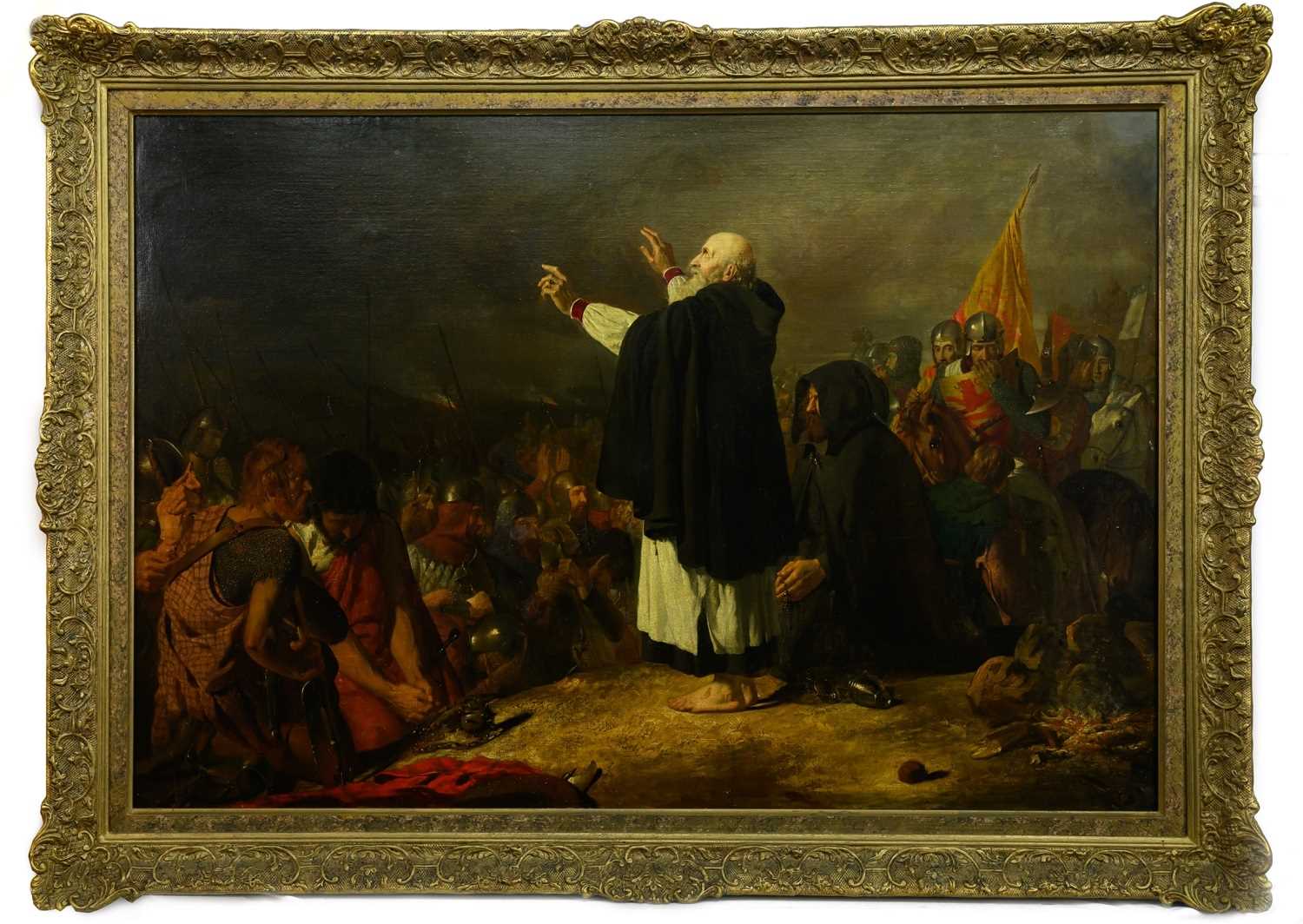THE BATTLE OF ALEXANDER THE GREAT AND KING PORUS IN INDIA: a miniature on a leaf of Roger of Lille’s (fl. 1208–13) Histoire ancienne jusqu’à César, IN FRENCH, illuminated manuscript on vellum[Northern France or Southern Netherlands?, 14th century (early)]
a leaf, c. 380 × 240mm, ruled in ink for two columns of 42 lines written in a fine gothic script, rubrics in red, the ruled space c. 250 × 165mm, the decorated with two-line initials alternately red or blue with penwork flourishing in the other colour, ILLUMINATED WITH A COLUMN-WIDE MINIATURE depicting two kings, with crowns, helmets, armour, shields, and lances, attacking one another on horseback, their shields and horses’ armorial caparisons with a gold wing on a blue ground (azure, a wing or) the other a white lion on a red ground (gules, a lion rampant argent), respectively, all against a gold background within a multicoloured border with white tracery; some fading, come overall cockling, some creases resulting in minor loss of pigment and gold, a small hole between the columns of text, the extremities somewhat darkened and with traces of mounting tape, the lower blank margin with a horizontal crease where folded to fit into a frame; in a double-sided frame.
PROVENANCESold in our rooms, 5 December 1989, lot 20, bought by:The Boehlen Collection, Bern, MS 1304.
TEXTThe text extends from ‘En celle valee iordea fu le roi alixandre & sa gent …’ to ‘… la royne Candace en grant chierte & en moult’; the miniature introduces a chapter with a rubric ‘Comment les .ii. rois vindrent toz ensemble armes a bataille’, which begins ‘Au ior qui estoit nomes revindrent els diu rois ensemble alixandre & porus armes de moult riches armes sur les destriers por fere la bataille …’. The equivalent text is transcribed from Paris, BnF, ms fr. 20125, fol. 249, on the ‘The Values of French’ website (tvof.ac.uk), Section 9 (Alexander), paragraphs 838–40, and the entire manuscript is digitised on the BnF’s website (gallica.bnf.fr).
The text does not appear to have any dialectical features that would help with localisation.
ILLUMINATIONThis is a very rare secular miniature of a classic medieval theme – knights in armour jousting. It represents the Battle of Hydaspes in 326 B.C. between Alexander the Great and Porus, king of the Punjab in India. It is apparently derived from a group of manuscripts written and illuminated at Acre in the Latin Kingdom of Jerusalem, or their earlier 13th-century French model. As Alison Stones kindly informs us, it is close in text and iconography to the Paris manuscript cited above, which was produced at Acre c. 1287 (Folda, 1976, pl. 88): this, and the manuscripts closely related to it, presumably returned to Europe after the fall of Acre in 1291, where they could serve as the exemplars for manuscripts such as the one from which the present leaf derives.
REFERENCESJaroslav Folda, Crusader Manuscript Illumination at Saint-Jean d’Acre, 1275–1291 (Princeton, 1976).
THE BATTLE OF ALEXANDER THE GREAT AND KING PORUS IN INDIA: a miniature on a leaf of Roger of Lille’s (fl. 1208–13) Histoire ancienne jusqu’à César, IN FRENCH, illuminated manuscript on vellum[Northern France or Southern Netherlands?, 14th century (early)]
a leaf, c. 380 × 240mm, ruled in ink for two columns of 42 lines written in a fine gothic script, rubrics in red, the ruled space c. 250 × 165mm, the decorated with two-line initials alternately red or blue with penwork flourishing in the other colour, ILLUMINATED WITH A COLUMN-WIDE MINIATURE depicting two kings, with crowns, helmets, armour, shields, and lances, attacking one another on horseback, their shields and horses’ armorial caparisons with a gold wing on a blue ground (azure, a wing or) the other a white lion on a red ground (gules, a lion rampant argent), respectively, all against a gold background within a multicoloured border with white tracery; some fading, come overall cockling, some creases resulting in minor loss of pigment and gold, a small hole between the columns of text, the extremities somewhat darkened and with traces of mounting tape, the lower blank margin with a horizontal crease where folded to fit into a frame; in a double-sided frame.
PROVENANCESold in our rooms, 5 December 1989, lot 20, bought by:The Boehlen Collection, Bern, MS 1304.
TEXTThe text extends from ‘En celle valee iordea fu le roi alixandre & sa gent …’ to ‘… la royne Candace en grant chierte & en moult’; the miniature introduces a chapter with a rubric ‘Comment les .ii. rois vindrent toz ensemble armes a bataille’, which begins ‘Au ior qui estoit nomes revindrent els diu rois ensemble alixandre & porus armes de moult riches armes sur les destriers por fere la bataille …’. The equivalent text is transcribed from Paris, BnF, ms fr. 20125, fol. 249, on the ‘The Values of French’ website (tvof.ac.uk), Section 9 (Alexander), paragraphs 838–40, and the entire manuscript is digitised on the BnF’s website (gallica.bnf.fr).
The text does not appear to have any dialectical features that would help with localisation.
ILLUMINATIONThis is a very rare secular miniature of a classic medieval theme – knights in armour jousting. It represents the Battle of Hydaspes in 326 B.C. between Alexander the Great and Porus, king of the Punjab in India. It is apparently derived from a group of manuscripts written and illuminated at Acre in the Latin Kingdom of Jerusalem, or their earlier 13th-century French model. As Alison Stones kindly informs us, it is close in text and iconography to the Paris manuscript cited above, which was produced at Acre c. 1287 (Folda, 1976, pl. 88): this, and the manuscripts closely related to it, presumably returned to Europe after the fall of Acre in 1291, where they could serve as the exemplars for manuscripts such as the one from which the present leaf derives.
REFERENCESJaroslav Folda, Crusader Manuscript Illumination at Saint-Jean d’Acre, 1275–1291 (Princeton, 1976).















Testen Sie LotSearch und seine Premium-Features 7 Tage - ohne Kosten!
Lassen Sie sich automatisch über neue Objekte in kommenden Auktionen benachrichtigen.
Suchauftrag anlegen